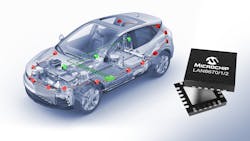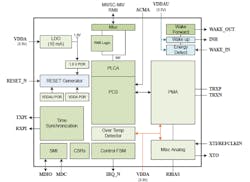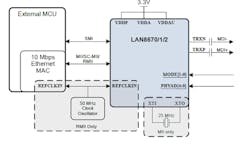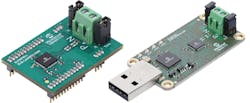10BASE-T1S PHYs Merge Low-Speed Devices into Automotive Ethernet
This article is part of the TechXchange: Single Pair Ethernet.
With all of the multilayered activity associated with a complete network installation along with “ethereal” software to make the network function, there’s still on inescapable fact: Any network’s capabilities begin the physical connection to the media, appropriately known as the PHY layer.
Adding to the automotive Ethernet momentum, Microchip Technology introduced AEC-Q100 Grade 1-qualified 10BASE-T1S Ethernet PHYs designed according to IEEE Std 802.3cg-2019): the LAN8670, LAN8671, and LAN8672. These enable connection of low-speed devices—primarily sensors and actuators—which previously required their own communication systems, into a standard-Ethernet system in automotive applications (Fig. 1).
The 10BASE-T1S device specifications include 10-Mb/s performance, half-duplex mode, flexible topology with multidrop bus line, and point-to-point, all using a single balanced pair of conductors (Fig. 2). The devices also feature enhanced electromagnetic compatibility/electromagnetic interference (EMC/EMI) performance, especially critical in the electrically harsh automotive environment.
Support for time-sensitive networking (TSN)—critical for many applications throughout automotive zonal architectures—enables synchronized timing across far-reaching Ethernet networks (Fig. 3).
These devices include advanced PHY diagnostics to provide the user with troubleshooting capabilities. In addition, sleep/wake functionality allows for low-power modes. While the three PHY interfaces share many of the same functions and features, they do have small but important differences in addition to their package size of small footprint 24-pin, 4- × 4-mm; 32-pin, 5- × 5-mm; and 36-pin, 6- × 6-mm VQFNs with wettable flanks (Fig. 4).
Design-in of network interfaces isn’t a trivial exercise. Microchip’s support for these ICs begins with a 37-page Product Brief, and continues with a 198-page full datasheet. There’s also a brief overview of 10BASE-T1S technology, which links to downloadable demo. Going further, there’s even a 54-minute online course “10BASE-T1S Single Pair Ethernet System Integration,” which introduces the 802.3cg short reach 10-Mb/s Ethernet physical-layer standard and the PLCA collision management protocol, allowing for efficient multi-drop network implementations.
For hands-on experience, Microchip offers two evaluation boards (Fig. 5). First, there’s the EVB-LAN8670-RMII, an RMII (Reduced Media Independent Interface)-to-10BASE-T1S interface card that connects to MCUs offering RMII and to Microchip MCU evaluation boards, with screw terminals for direct cable connection. The second board, the EVB-LAN8670-USB, is a USB-to-10BASE-T1S interface card also with screw terminals.
About the Author

Bill Schweber
Contributing Editor
Bill Schweber is an electronics engineer who has written three textbooks on electronic communications systems, as well as hundreds of technical articles, opinion columns, and product features. In past roles, he worked as a technical website manager for multiple topic-specific sites for EE Times, as well as both the Executive Editor and Analog Editor at EDN.
At Analog Devices Inc., Bill was in marketing communications (public relations). As a result, he has been on both sides of the technical PR function, presenting company products, stories, and messages to the media and also as the recipient of these.
Prior to the MarCom role at Analog, Bill was associate editor of their respected technical journal and worked in their product marketing and applications engineering groups. Before those roles, he was at Instron Corp., doing hands-on analog- and power-circuit design and systems integration for materials-testing machine controls.
Bill has an MSEE (Univ. of Mass) and BSEE (Columbia Univ.), is a Registered Professional Engineer, and holds an Advanced Class amateur radio license. He has also planned, written, and presented online courses on a variety of engineering topics, including MOSFET basics, ADC selection, and driving LEDs.





